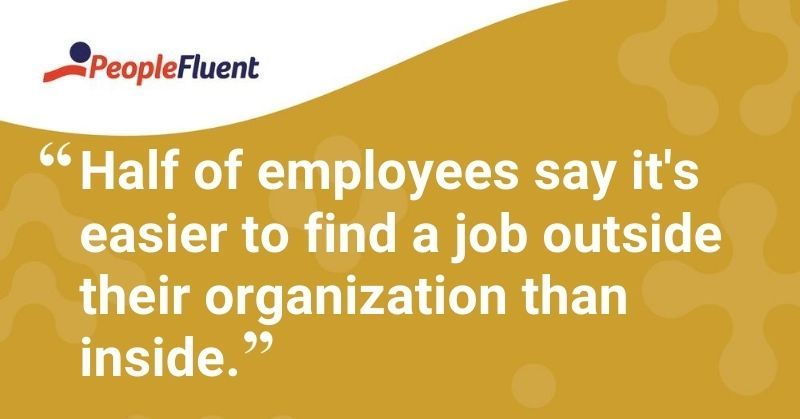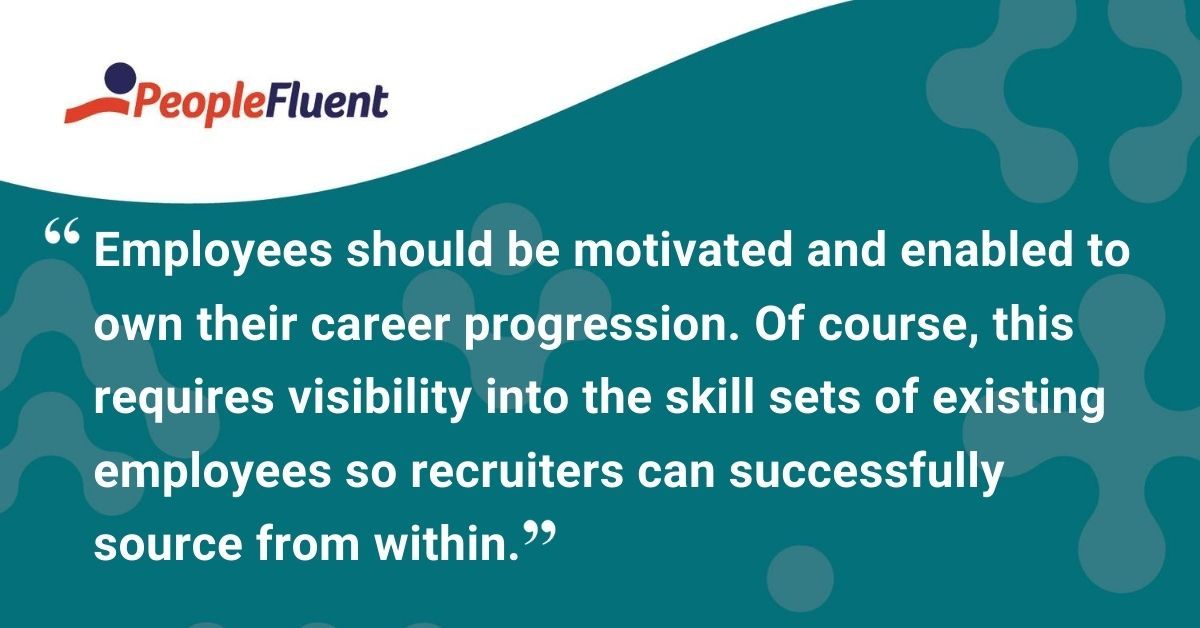Published: Sep 3, 2020Time to read: 5mins Category: Insights
Hiring From Within: How To Create a Culture of Internal Mobility
Table of Contents
Although an organization’s largest talent source may be its own people, many companies find it difficult to access great internal talent. Most recruiters and hiring managers focus on external candidates to fill new roles. However, a shifting business landscape and the need to satisfy employee development goals can be overcome by looking within and providing new opportunities for top performers already in the business. Here’s how to get it right.
Internal mobility is typically associated with an existing employee moving to a new position within the organization. However, there are more ways to achieve internal talent mobility than simply filling a role with a current employee. Company leaders must look for other ways to meet development opportunities while also filling critical roles for the business.
According to LinkedIn’s 2018 Workforce Learning Report, nearly 95% of employees stated they would remain with a company longer if it made an investment in their careers. This opens up a peripheral opportunity for organizations to increase employee retention and bolster the reskilling process—all while taking a holistic approach to the organization’s needs.
Furthermore, as organizations reimagine today’s talent journey, they’re putting greater emphasis on the employee experience. Organizations need to develop talent strategies that connect top performers to growth opportunities, build their skills, and put them in the best position to keep them engaged.
Related reading: ‘5 Steps To Transform Your Talent Pipeline’
Why Is Internal Mobility Important?
Internal mobility is an important function for organizations to explore. Consider these reasons:
- Employees may want to make a career change but aren’t keen on leaving their current employer.
- Internal mobility helps organizations build a collaborative and agile company culture, which are key aspects of improving employee engagement.
- Establishing an internal career program provides employees with a way to take ownership of reskilling themselves.
Internal mobility is also a great opportunity for organizations looking to expand into new territories. The expansion may require them to open new headquarters across the world and present the need to source employees with extensive knowledge and experience with the opportunity to work in a new location—either from home or an office.

You might also like: ‘How COVID-19 Has and Will Change Recruiting Strategies’
Why Is Internal Mobility a Challenge?
Based on a survey in the 2019 Global Human Capital Trends report by Deloitte, 50% of respondents said it was easier for employees to find a job outside their organization than inside. While this can be remedied with a strong internal mobility program, it’s important for companies to understand why these initiatives often fail.
Some of the main reasons why developing and executing a successful internal mobility program may be a challenge are:
- lack of processes to identify and move people throughout the organization
- low availability of internal employees to fill roles
- resistance from current managers
- lack of visibility on internal roles for existing employees
Another big reason is a lack of visibility into employee skills, interests, and career aspirations. Organizations can overcome this specific blocker by building talent profiles that help connect employees with learning opportunities—allowing employees to make a strategic move to a new role or expand on their current role.
More from the blog: 'How Talent Experience Benefits Employee and Employer'
How To Overcome Roadblocks To Internal Mobility
There are three main stakeholders in an internal mobility strategy:
- the employee
- the current and hiring managers
- the talent team
These individuals must work together to ensure successful internal mobility initiatives that last. The talent team consists of those who are focused on acquiring talent externally or internally, rather than retaining talent.
In the case of current managers, they may not be the best promoters of internal mobility. However, this isn’t because current managers want to hold their employees back. Rather, they’re concerned about losing productivity due to the “hole” left on their team—especially since this gap may go unfilled for months.
Hiring managers for the internal roles can cause friction without even knowing it. For instance, if a recruiter identifies an internal candidate with the necessary skills, hiring managers should continue to move this candidate through the hiring process before requesting an additional two or three external candidates. If internal employees are overlooked by hiring managers who are more interested in external talent, the company might risk losing the existing employee to another organization.
Employees who are interested in growing with the company and are considered to be ‘great internal talent’ may feel they belong at the front of the line for a specific role. And, employees should be motivated and enabled to own their career progression. Of course, this requires visibility into the skill sets of existing employees so recruiters can successfully source from within.

Keep reading: ‘Talent Acquisition Triple Play: 3 Elements of a Successful Recruiting Strategy’
For example, an employee who works in the Customer Service Department, and has graphic design or marketing skills, should understand that their current role isn’t the final career path. Managers and leaders should find ways to help the employee work across different departments on small projects. This allows the employee to gain real-life experience and work on something they have the skills and passion for.
Establishing greater visibility into internal mobility across your organization—for hiring managers and individual employees—will help create a deeper understanding of the necessary skill sets for a role and which employees might have them. And, more insight into how possible opportunities in the business can help create progression or lateral movement for different positions.
Ready to start sourcing the best talent within your organization?
Find out how PeopleFluent can help your organization create a culture of internal mobility.